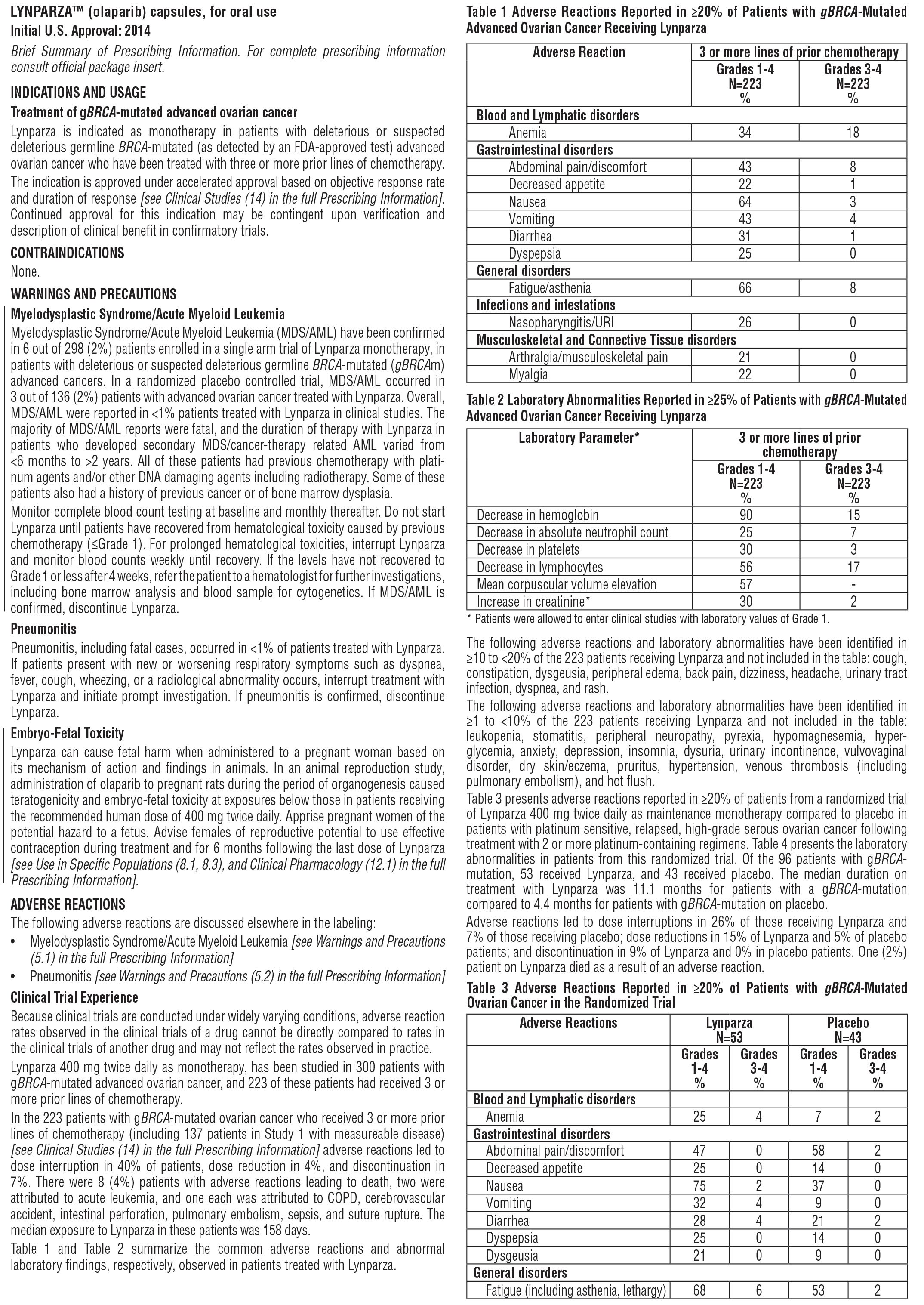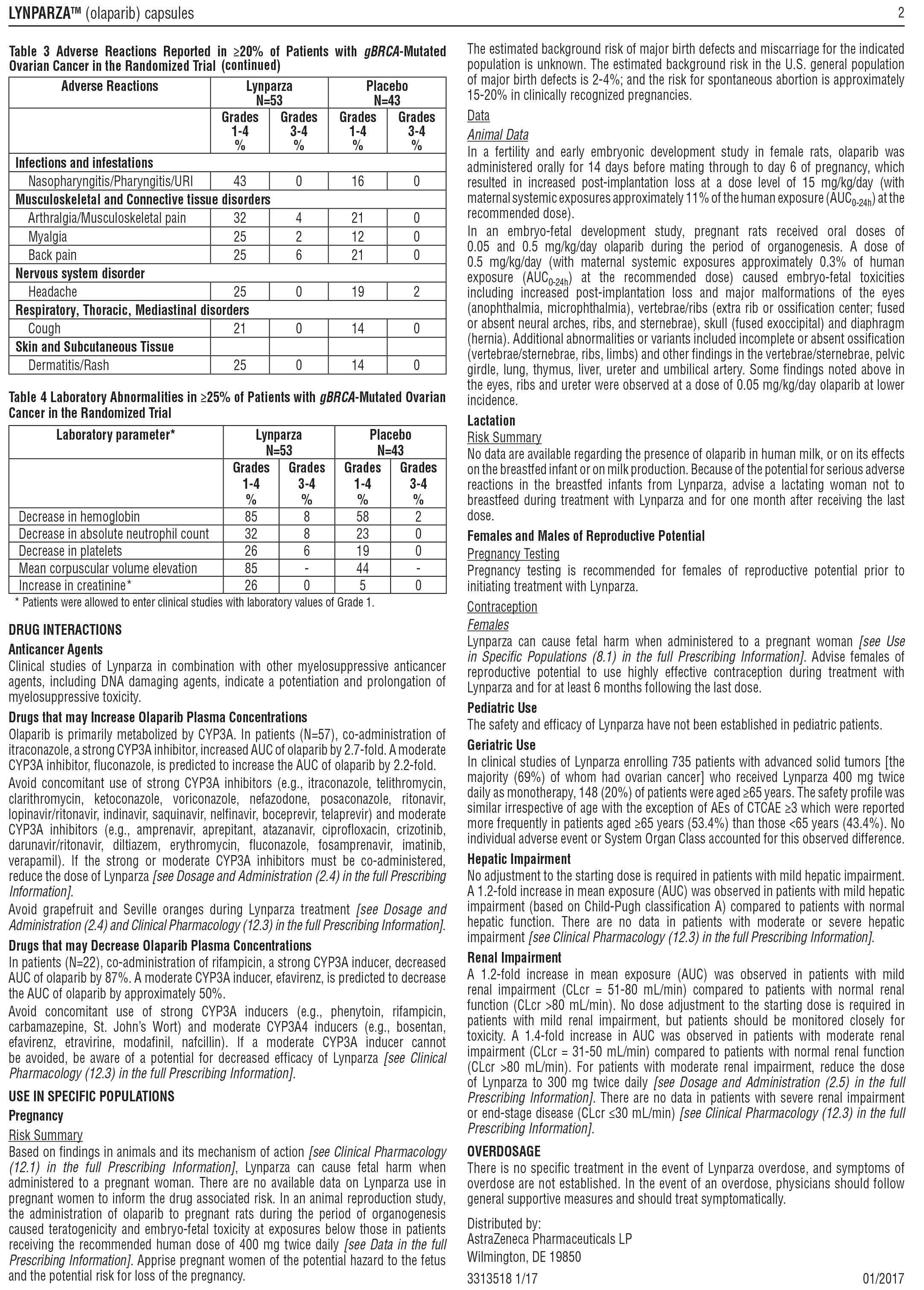Article
AstraZeneca: Pioneers in Ovarian Cancer
Author(s):
Since the approval of LYNPARZA, over 3,000 US women with germline BRCA-mutated advanced ovarian cancer have been treated with this important medicine.
Over two years ago, women diagnosed with germline BRCA-mutated advanced ovarian cancer had limited treatment options, including chemotherapy or investigational treatments through clinical trials.
In late 2014, AstraZeneca was proud to introduce a new treatment option, with the US FDA accelerated approval of LYNPARZATM (olaparib) as a monotherapy for the treatment of deleterious or suspected deleterious germline BRCA-mutated (as detected by an FDA-approved test) advanced ovarian cancer, for patients who have been treated with three or more prior lines of chemotherapy. LYNPARZA was the first approved poly (ADP-ribose) polymerase (PARP) inhibitor and has more than two years of patient experience. LYNPARZA has serious risks including myelodysplastic syndrome/acute myeloid leukemia, pneumonitis, and embryo-fetal toxicity. To learn more, read the Important Safety Information on the adjacent page.
More than two years since the approval of LYNPARZA, over 3,000 US women with germline BRCA-mutated advanced ovarian cancer have been treated with this important medicine. This wouldn’t have been possible without the many women who participated in clinical trials. Thanks to their participation, the relentless commitment of global researchers and tireless efforts by advocacy groups to raise awareness and support for funding, LYNPARZA is now an important treatment option.
Over the past decade, research in DNA Damage Response (DDR) and other areas have made considerable progress in understanding the underlying disease mechanisms in advanced ovarian cancer, and at AstraZeneca, we are humbled to have played a role in this research.
AstraZeneca is proud to be a pioneer and will continue to advance DDR research - a journey that is far from complete.
We look forward to continued collaboration with advocacy groups and health care professionals to advance ovarian cancer research.
Sincerely,

Andrew Coop
Vice President
Medical Affairs, US Oncology
AstraZeneca
You are encouraged to report negative side effects of prescription drugs to the FDA. Visit www.fda.gov/medwatch or call 1-800-FDA-1088.
Please see Important Safety Information on following page and accompanying Brief Summary of the full Prescribing Information.
To learn more about LYNPARZA please visit www.lynparzahcp.com.
Indications and Usage
LYNPARZA is a poly (ADP-ribose) polymerase (PARP) inhibitor indicated as monotherapy in patients with deleterious or suspected deleterious germline BRCA-mutated (as detected by an FDA-approved test) advanced ovarian cancer who have been treated with three or more prior lines of chemotherapy.
The indication is approved under accelerated approval based on objective response rate and duration of response. Continued approval for this indication may be contingent upon verification and description of clinical benefit in confirmatory trials.
IMPORTANT SAFETY INFORMATIONWARNINGS AND PRECAUTIONS
There are no contraindications for LYNPARZA.
Myelodysplastic Syndrome/Acute Myeloid Leukemia (MDS/AML): Occurred in <1% of patients treated with LYNPARZA, and the majority of those reports were fatal. The duration of therapy in patients who developed secondary MDS/AML varied from <6 months to >2 years. In a randomized placebo-controlled trial, MDS/AML occurred in 2% of patients treated with LYNPARZA. All of these patients had previous chemotherapy with platinum agents and/or other DNA damaging agents, including radiotherapy, and some of these patients also had a history of previous cancer or of bone marrow dysplasia.
Monitor patients for hematological toxicity at baseline and monthly thereafter. Do not start LYNPARZA until patients have recovered from hematological toxicity caused by previous chemotherapy (≤Grade 1). For prolonged hematological toxicities, interrupt LYNPARZA and monitor blood counts weekly until recovery. If the levels have not recovered to Grade 1 or less after 4 weeks, refer the patient to a hematologist for further investigations, including bone marrow analysis and blood sample for cytogenetics. Discontinue if MDS/AML is confirmed.
Pneumonitis: Occurred in <1% of patients exposed to LYNPARZA, and some cases were fatal. If patients present with new or worsening respiratory symptoms such as dyspnea, fever, cough, wheezing, or a radiological abnormality occurs, interrupt treatment with LYNPARZA and initiate prompt investigation. Discontinue if pneumonitis is confirmed.
Embryo-Fetal Toxicity: LYNPARZA can cause fetal harm. A pregnancy test should be performed on all pre-menopausal women prior to treatment. Advise females of reproductive potential of the potential risk to a fetus and to use effective contraception during treatment and for six months after receiving the final dose.
ADVERSE REACTIONS
In clinical studies, the most common adverse reactions (Grades 1-4) in ≥20% of patients included anemia (34%), nausea (75%), fatigue (including asthenia) (68%), vomiting (43%), diarrhea (31%), dysgeusia (21%), dyspepsia (25%), headache (25%), decreased appetite (25%), nasopharyngitis/pharyngitis/URI (43%), cough (21%), arthralgia/musculoskeletal pain (32%), myalgia (25%), back pain (25%), dermatitis/rash (25%), and abdominal pain/discomfort (47%).
Common lab abnormalities (Grades 1-4) included decrease in hemoglobin (90%), decrease in absolute neutrophil count (32%), decrease in platelets (30%), decrease in lymphocytes (56%), mean corpuscular volume elevation (85%), and increase in creatinine (30%).
DRUG INTERACTIONS
Anticancer Agents: Clinical studies of LYNPARZA in combination with other myelosuppressive anticancer agents, including DNA damaging agents, indicate a potentiation and prolongation of myelosuppressive toxicity.
CYP3A Inhibitors: Avoid concomitant use of strong and moderate CYP3A inhibitors. If the strong or moderate CYP3A inhibitor must be co-administered, reduce the dose of LYNPARZA. Advise patients to avoid grapefruit and Seville oranges during LYNPARZA treatment.
CYP3A Inducers: Avoid concomitant use of strong and moderate CYP3A inducers when using LYNPARZA. If a moderate inducer cannot be avoided, be aware of a potential for decreased efficacy of LYNPARZA.
USE IN SPECIFIC POPULATIONS
Lactation: No data are available regarding the presence of olaparib in human milk, the effects on the breastfed infant or on milk production. Because of the potential for serious adverse reactions in the breastfed infant, advise a lactating woman not to breastfeed during treatment with LYNPARZA and for one month after receiving the final dose.
Hepatic Impairment: No dose adjustment is required in patients with mild hepatic impairment (Child-Pugh classification A). There are no data in patients with moderate or severe hepatic impairment.
Renal Impairment: No dosage adjustment is necessary in patients with mild renal impairment (CLcr 51-80 mL/min). In patients with moderate renal impairment (CLcr 31-50 mL/min), reduce the dose to 300 mg twice daily. There are no data in patients with severe renal impairment or end-stage renal disease (CLcr ≤30 mL/min).


Please see complete Prescribing Information, including Patient Information (Medication Guide). http://www.azpicentral.com/Lynparza/pi_lynparza.pdf
Our scientists recognized early on that this molecule showed potential. After 10 years of testing and probing hypotheses, they discovered that LYNPARZA may exploit tumor DNA damage response (DDR) pathway deficiencies to potentially kill cancer cells. The exact mechanism of action of LYNPARZA remains a subject of research.